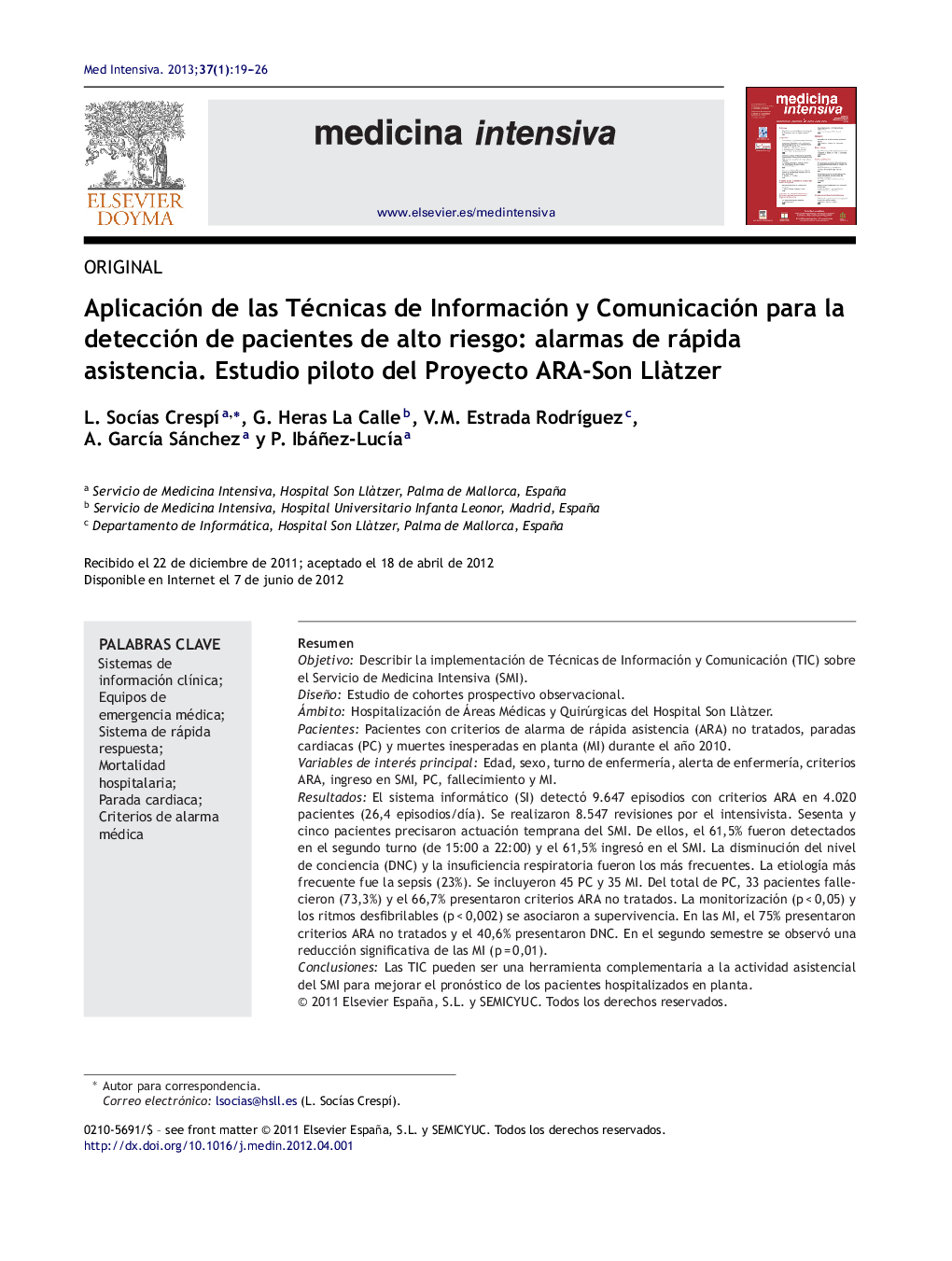| کد مقاله | کد نشریه | سال انتشار | مقاله انگلیسی | نسخه تمام متن |
|---|---|---|---|---|
| 3113267 | 1192367 | 2013 | 8 صفحه PDF | دانلود رایگان |

ResumenObjetivoDescribir la implementación de Técnicas de Información y Comunicación (TIC) sobre el Servicio de Medicina Intensiva (SMI).DiseñoEstudio de cohortes prospectivo observacional.ÁmbitoHospitalización de Áreas Médicas y Quirúrgicas del Hospital Son Llàtzer.PacientesPacientes con criterios de alarma de rápida asistencia (ARA) no tratados, paradas cardiacas (PC) y muertes inesperadas en planta (MI) durante el año 2010.Variables de interés principalEdad, sexo, turno de enfermería, alerta de enfermería, criterios ARA, ingreso en SMI, PC, fallecimiento y MI.ResultadosEl sistema informático (SI) detectó 9.647 episodios con criterios ARA en 4.020 pacientes (26,4 episodios/día). Se realizaron 8.547 revisiones por el intensivista. Sesenta y cinco pacientes precisaron actuación temprana del SMI. De ellos, el 61,5% fueron detectados en el segundo turno (de 15:00 a 22:00) y el 61,5% ingresó en el SMI. La disminución del nivel de conciencia (DNC) y la insuficiencia respiratoria fueron los más frecuentes. La etiología más frecuente fue la sepsis (23%). Se incluyeron 45 PC y 35 MI. Del total de PC, 33 pacientes fallecieron (73,3%) y el 66,7% presentaron criterios ARA no tratados. La monitorización (p < 0,05) y los ritmos desfibrilables (p < 0,002) se asociaron a supervivencia. En las MI, el 75% presentaron criterios ARA no tratados y el 40,6% presentaron DNC. En el segundo semestre se observó una reducción significativa de las MI (p = 0,01).ConclusionesLas TIC pueden ser una herramienta complementaria a la actividad asistencial del SMI para mejorar el pronóstico de los pacientes hospitalizados en planta.
ObjectiveTo describe the implementation of a Medical Information System (MIS) in the Critical Care Departament (CCD).DesignA prospective observational cohort study was carried out.SettingClinical and Surgical wards in Son Llàtzer Hospital.PatientsPatients with criteria of rapid care alert (RCA) without treatment, cardiac arrest (CA), and unexpected ward deaths (UWD), during 2010.Main variablesAge, sex, nursing shift, nursing alert, vital signs, unplanned admission to intensive care, CA, UWD and death.ResultsThe MIS detected 9647 episodes with RCA signs in 4020 patients (26.4 episodes/day). A total of 8547 episodes were reviewed. Sixty-five patients required rapid response by the intensive care staff; 61.5% were detected in the afternoon shift (15:00 a 22:00), and 61.5% were admitted to the CCD. Diminished consciousness (DC) and respiratory failure were the most frequent problems. The sepsis rate was 23%. We reviewed 45 CA and 35 UWD. Of the total cases of CA, 33 patients died (73.3%) and 66.7% had criteria of untreated RCA. Monitoring (P < .05) and rhythms amenable to defibrillation (P < .002) were associated to survival. As regards the UWD, 75% had criteria of untreated RCA, and 40.6% presented diminished consciousness. In the last 6 months there was a significant reduction in UWD (P = .01)ConclusionsThe MIS could be a complimentary tool in the activity of the CCD to improve the prognosis of hospitalized patients
Journal: Medicina Intensiva - Volume 37, Issue 1, January–February 2013, Pages 19–26